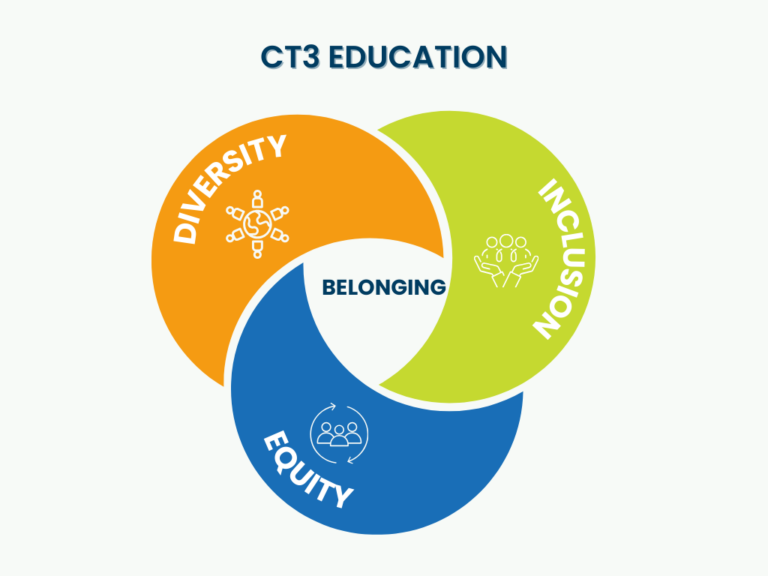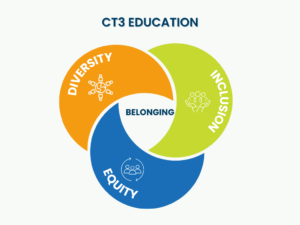Teaching Every Student Every Day
Promoting Diversity and Inclusion in the Classroom
- By SJT, CT3 Associate
Every Student, Every Day is the name of our mentor text that explains our No Nonsense Nurturing philosophy of equity and inclusion in the classroom. This means that educators are accountable for driving positive academic and social outcomes for 100% of our students every day. We invest equitably in all of our students so they can be successful in school, college/career, and life!
In 2022, the U.S. had 45% White American scholars, 15% African American scholars, 29% Hispanic scholars, 5% Asian, and 7% of scholars who are multiracial/other races. With this increasing educational diversity, it is necessary to understand diverse needs and make intentional efforts to foster a sense of belonging for all members of our school communities. Teachers can actively promote diversity in the classroom by elevating the different cultures, customs, and experiences of scholars.
This rapid increase in educational diversity has had additional implications for K-12 educators. All educators can benefit greatly from DEI education. At these trainings, they learn how policies and individual biases and behaviors have contributed to inequitable outcomes. They also learn new ways to overcome common barriers and replace them with more equitable practices. Teachers and administrators can support this DEI* awareness organically by soliciting voice in decision making from scholars, families, and community partners. Thereby including the culture and needs of the community which promotes diversity in the classroom.
In order to effectively teach and drive results for 100% of students, schools must employ intentional practices to create an inclusive school environment. Leaders must ensure each student is seen, engaged, supported, and educated. Successful leaders create systems to foster inclusion in the classroom by providing diversity and inclusion training in their schools.
DEI Definition (for this article*)
| Diversity | A variety of people within a population with different racial, social, neurological, physical, cultural, economical backgrounds and experiences |
| Inclusion | Intentional practices to make sure all members of a community feel an authentic sense of belonging |
| Equity | All people have access to what they need to reach their full potential and experience success |
All communities have diversity, even schools that appear to be homogeneous have socioeconomic, cultural, religious, linguistic, and, learning differences. There is also increased awareness in K-12 schools around diversity in sexuality and gender identity/expression. There are so many ways people can be different. More than meets the eye. That is why diversity and inclusion education in schools is important for all staff. This equips educators to recognize scholars’ unique needs and seize opportunities to more fully support and include them.
It is imperative that all leaders use strategies to engage and educate every student every day. Here are some concrete strategies you can employ to help increase the level of inclusion and support equitable outcomes for our increasingly diverse schools:
- 100% are Seen:
-
- Greet each Student: Learn to correctly pronounce their names and greet them warmly by name every day
- Notice their Interests: Pay attention to what they are interested in. What books, videos, games, sports, social media trends/influencers, or activities are they already into?
- Honor Special Occasions: Celebrate birthdays for scholars and staff. Show respect for holidays, traditions and customs celebrated by members of your community. Celebrate shared occasions at the school!
- Showcase your People: Display pictures of scholars and staff in the school. Proudly display work made by the students. Create opportunities for all students to present and showcase their work. Students should be both seen and heard in the school!
- 100% are Engaged:
-
- Use precise directions and positive narration to equitably engage all students.
- Be respectfully curious to learn about differences.
- Celebrate shared aspects of culture and during your class and school celebrations.
- Create authentic opportunities to learn about the different cultures and customs within the community.
- Leaders should actively seek community partnerships that are relevant and representative for the student body.
- School faculty regularly engage parents, make translation services available, and include parents in decision making for their child and school. (i.e. PTA, volunteering, Title I parent representative, etc.)
- 100% are Supported:
-
- Schools use a Social-Emotional Learning program to proactively teach the social skills that are needed to thrive in a diverse environment.
- MTSS tiered supports are aligned to the specific needs of the students. Data is used thoughtfully to plan interventions which support equity in the classroom.
- Non-profits, religious centers, and other community groups can often provide wrap-around services to address family or social needs that are beyond what the school can support. These partnerships can provide essential services especially if there is a culture gap between the school staff and the students who need this additional support.
- 100% are Educated:
-
- Invest specialized training for teachers who support diverse learners: General education teachers, special educators, interventionists, behavior support staff, and ELL teachers should receive regular diversity training to support equity in the classroom.
- Instructional materials are curated to represent and reflect the stories, experiences, and elevate the assets within the student body
- Teachers create meaningful opportunities for academic collaboration and cooperative learning among students.
- Classroom teachers and specialists collaborate to provide differentiated instruction for students with diverse learning needs.
To close, diversity may or may not be intentional. Sometimes a community is already diverse and some schools can reflect a subtle segregation among the groups there if there is not intention around inclusion. Creating an inclusive environment and working toward equitable outcomes for all students is a commitment that school teams make. In order to foster a strong sense of belonging, we must see and value all people. Build on the existing diversity that exists in our communities. Take thoughtful actions to engage students and families to cultivate an inclusive climate. Use data and feedback to make informed decisions about the specific supports and differentiated educational practices are the prerequisite to equitable educational outcomes for all students.




